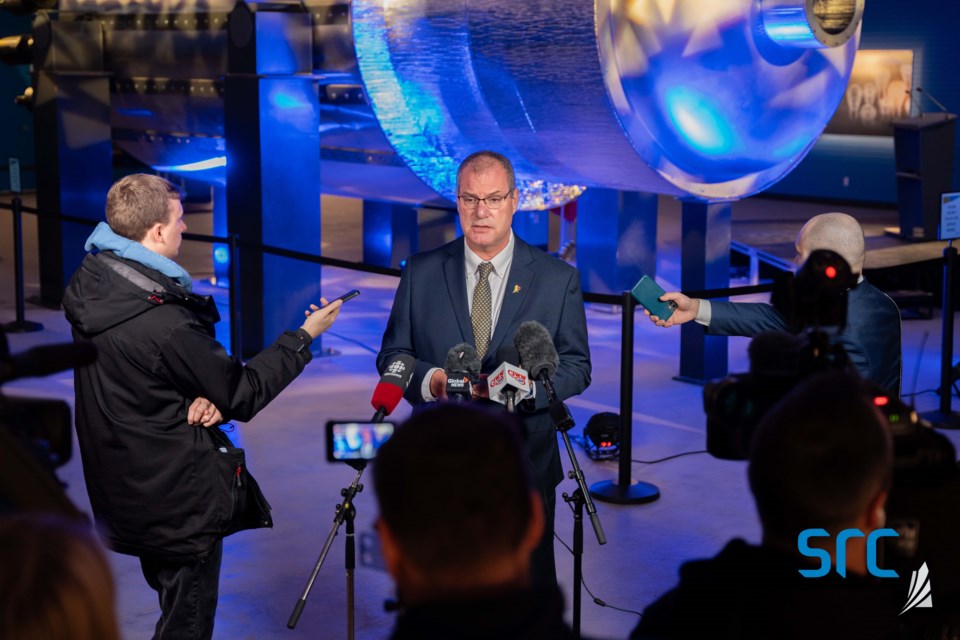MOOSEJAWTODAY.COM — Mike Crabtree, president and CEO of the Saskatchewan Research Council (SRC), said the province's new $80 million commitment to nuclear microreactors, in partnership with Westinghouse Electric, could position Saskatchewan as a world leader in nuclear energy.
"This project will, eventually, be the first of its kind in the world," Crabtree told MooseJawToday.com, "so there is a very significant partnership between SRC and Westinghouse in developing particularly the applications of how this (microreactor) will be used, but also in developing the processes that will take us through the licensing, regulatory, and siting requirements, which together form the longest lead time item in this five-year process between now and hopefully bringing the reactor into the province."
On November 27, to pursue a working, contributing demonstration microreactor, expected to be online in 2029.
The development is the result of more than three years of co-operation between Westinghouse Electric Company and the SRC, The SRC has a long history of safe nuclear research. It was one of the first companies in Canada to become a licensed reactor operator with the Canadian Nuclear Safety Commission (CNSC), and operated a SLOWPOKE-2 nuclear research reactor for 38 years before decommissioning it in 2021.
"We've been a safe pair of hands in the nuclear sector for a considerable period of time, now," Crabtree said. "This is a really big step forward, though, because the microreactor, although it is 'micro', is essentially a nearly 15-megawatt nuclear battery. To put it in context, that is sufficient to power about 3,000 homes."
Crabtree said that once the reactor is operating, it will be put into use and is expected to pay for itself over time by supplying industrial heat and power. There is potential in Saskatchewan for at least 10-15 of these batteries, he noted, which would have major implications for spin-off industries to support them. The biggest potential is in providing remote communities, industry sites, research outposts, and more with continuous, clean energy through a combination of wind, solar, and nuclear.
The eVinci™ microreactor will be built by Westinghouse, with the location of the reactor to be determined as the project progresses through the regulatory processes. The required surrounding infrastructure is less than two thirds the size of a hockey rink. The eVinci™ is capable of producing five megawatts of electricity, over 13 megawatts of high temperature heat, or operating in combined heat and power mode.
"Westinghouse is proud to be working with the team at SRC on this vital project, and for the support from Premier Moe and the Government of Saskatchewan," said Patrick Fragman, Westinghouse's president and CEO. "The eVinci™ battery technology is the perfect fit for Saskatchewan since it is fully transportable. It also provides carbon-free electricity and heat, uses no water, and can be completely removed from site after operating continuously for eight years or more."
Saskatchewan could be positioned as a global leader in nuclear energy
Cameco, a Saskatoon-based company and the world's largest publicly traded uranium producer, . That means that, while manufacture of eVinci reactors will remain in the US, there is potential for Saskatchewan to be the location of the maintenance of those reactors, first to fellow Canadian jurisdictions, and from there to clients around the world.
"I think the really compelling opportunity that we want to pursue for Saskatchewan, particularly with Cameco now owning 49 per cent of Westinghouse, is that Saskatchewan will become a staging area ... for the rest of Canada," Crabtree said. "We can see that the reactors will come fueled from the factory, but they could be re-fueled here in the future."
The batteries are essentially rechargeable — once the initial fuel has been exhausted, they can be swapped out for another fully fueled microreactor. The exhausted reactor is removed to a staging point where the old fuel is safely extracted and replaced, whereupon the eVinci is sent back out for another 8-10 years of use. It only takes about a month to power an eVinci up, or back down, from a completely inert state, making it safe to transport — and they are so small they can fit in a seacan.
What about the waste, and the cost?
"The math on this is changing and will continue to change as we move forward ... but they are going to be highly competitive with the diesel power these remote sites currently depend on," Crabtree said. "And again, part of the attractiveness of these is that there's never any exposed fuel at the location. The battery is sent fully charged and withdrawn fully discharged. In terms of actual waste, from the 10 years of operation, supplying power equivalent to 3,000 homes, that will result in about three 200-litre drums of nuclear waste.
"A lot of the work we'll be doing over the next five years will involve ... what happens to the spent fuel, but if you look at the stark math ... those three drums of spent nuclear fuel are replacing the equivalent of a million drums of diesel. That's 1.3 million barrels, by the way, because of course a drum is bigger than a barrel. And that avoids half a million tonnes of CO2. It really is staggering."
Learn more and follow along with SRC public engagement events at .
In response to some providers blocking access to Canadian news on their platforms, our website, MooseJawToday.com will continue to be your source for hyper-local Moose Jaw news. Bookmark and to read the latest local developments.




